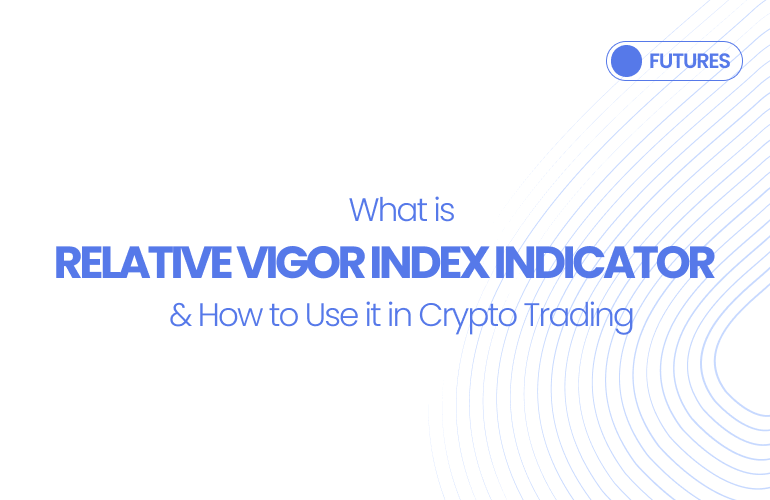The Relative Vigor Index (RVI) is a momentum oscillator that compares a candle’s close with its open, normalised by the day’s range. On Pi42, India’s first crypto-INR perpetual futures platform, this tool helps traders refine entries and exits across BTC-INR, ETH-INR, SOL-INR, MATIC-INR, and XRP-INR contracts.
How to Read the Relative Vigor Index Indicator?
The Relative Vigor Index usually appears as two lines below the price chart:
- RVI Line: measures how strongly prices close compared to where they opened, adjusted for the day’s range.
- Signal Line: a smoothed average of the RVI line, used to confirm signals.
Some Key Points to Understand
- Midline (0 or 50):
- When plotted around zero, readings above zero suggest bullish momentum.
- If scaled to 0–100, values above 50 lean bullish and below 50 lean bearish.
- When plotted around zero, readings above zero suggest bullish momentum.
- Crossovers:
- RVI above Signal: momentum is strengthening, which can support buy setups.
- RVI below Signal: momentum is weakening, which can support sell setups.
- RVI above Signal: momentum is strengthening, which can support buy setups.
- Context Matters:
- RVI signals are stronger when they align with the broader trend.
- Combine with support, resistance, or volume for confirmation.
- RVI signals are stronger when they align with the broader trend.
What does an RVI above 50 indicate?
If your charting package rescales RVI to 0–100, above 50 means recent closes tend to be stronger than opens in uptrends, which supports continuation. In ranges, it can be a short-term bullish bias that still needs confirmation from price action or volume.
What does an RVI below 50 indicate?
On a rescaled plot, below 50 shows closes are weaker than opens on average in downtrends, which confirms seller control. Within ranges, it may tilt bearish. However, it should be paired with structure and risk controls to avoid whipsaws.
Relative Vigor Calculator: Formula and terms
The Relative Vigor Index (RVI) measures how strongly prices close relative to their opens, adjusted by the day’s range. It uses a smoothing technique to reduce noise and capture consistent momentum.
A common formulation smooths both the numerator and denominator with four-bar weights:
RVI = ((C – O) + 2(C-1 – O-1) + 2(C-2 – O-2) + (C-3 – O-3)) /
((H – L) + 2(H-1 – L-1) + 2(H-2 – L-2) + (H-3 – L-3))
Signal = (RVI + 2*RVI-1 + 2*RVI-2 + RVI-3) / 6
Explanation of Terms
- C, O, H, L: close, open, high, and low prices.
- Subscript −1, −2, −3: prior bars or periods.
- Numerator: shows how strong the close is compared to the open (price momentum).
- Denominator: reflects price range, normalising momentum for volatility.
- Smoothing: applies a weighted average (1,2,2,1) to filter noise and produce smoother crossovers.
Why the 14-Period Calculation is Commonly Used (Example)
Most traders prefer the 14-period RVI because it balances sensitivity and stability—similar to other oscillators like RSI. For example, on a BTC-INR 1-hour chart:
- 7-period RVI: reacts quickly but may give false signals.
- 14-period RVI: reduces noise while remaining responsive.
- 20-period RVI: smoother but slower to confirm trend changes.
Relative Vigor Index Strategy
Baseline rules:
- Trend filter: 50-period moving average up for longs, down for shorts.
- Entry: Long when RVI crosses above Signal and price trades above the MA. Short when RVI crosses below Signal and the price is below the MA.
- Risk: Place stops beyond the recent swing or use an ATR multiple.
- Exit: Opposite crossover, key level breach, or time-based stop.
RVI in Trend Confirmation
Use Relative Vigor Index to confirm direction rather than to predict turns:
- Uptrend: higher highs and higher lows with RVI above the Signal on pullbacks.
- Downtrend: lower highs and lower lows with RVI under the Signal on rallies.
How to use RVI for Confirming Strong Trends and Avoiding False Breakouts?
Here are some practical steps you can take to filter traps:
- Wait for alignment: Breakout on price, RVI above Signal, and volume expansion.
- Retest logic: If price retests the breakout level while RVI stays constructive, conviction improves.
- Time filter: Require the breakout to hold for a fixed number of candles before entry.
- Fail-safe: If RVI flips against you quickly, reduce size or exit.
Combining RVI with Other Indicators
Here’s how you can pair Relative Vigor Index with tools that complement it:
- Moving Averages (trend): 20-EMA for short-term bias, 50-SMA for structure. The RVI crossover against the dominant MA often underperforms.
- MACD (impulse): Execute only when RVI and MACD both point in the same direction. The MACD histogram turning up while the RVI crosses up can signal momentum synchrony.
- Structure and levels: Confluence with support, resistance, or round numbers adds quality.
For more context, explore our guide on types of technical indicators.
RVI in Crypto Market Divergence
Divergence occurs when price and RVI move in different directions. In 24×7 RVI crypto markets, divergence can flag fatigue.
Bullish Divergence
Price makes a lower low, while RVI forms a higher low. Traders look for:
- A crossover of RVI above Signal after the higher-low on RVI.
- A reclaim of a support level or a moving average.
- Tight risk below the recent swing.
Bearish Divergence
Price makes a higher high, while RVI prints a lower high, suggesting that buyers are tiring. Traders may consider:
- RVI crossing below Signal as momentum cools.
- Failure at resistance or a break back under the moving average.
- Defined risk above the recent swing.
The Need for Relative Vigor Index
When used with discipline, the RVI sharpens entries, exits, and confirmations in crypto-INR futures. On Pi42, you need to apply these rules across supported pairs.
Crypto Reads You’ll Love
Crypto Trading for Beginners: Easy Steps to Get Started
What is Contract Trading in Crypto & How Does it Work?
What Are Perpetual Futures Contracts and How Do They Work?

